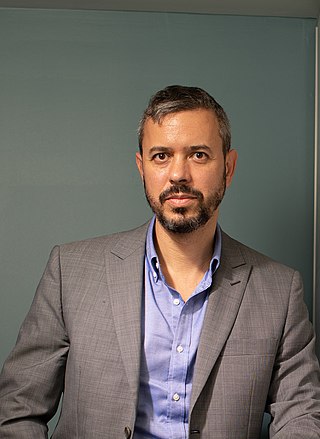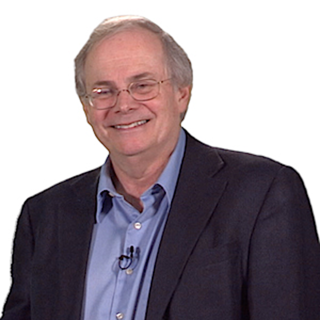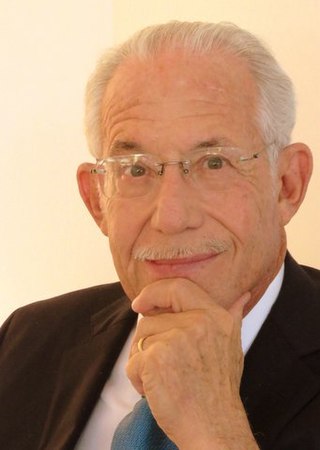
A model organism is a non-human species that is extensively studied to understand particular biological phenomena, with the expectation that discoveries made in the model organism will provide insight into the workings of other organisms. Model organisms are widely used to research human disease when human experimentation would be unfeasible or unethical. This strategy is made possible by the common descent of all living organisms, and the conservation of metabolic and developmental pathways and genetic material over the course of evolution.

Mitochondrial DNA is the DNA located in mitochondria, cellular organelles within eukaryotic cells that convert chemical energy from food into a form that cells can use, such as adenosine triphosphate (ATP). Mitochondrial DNA is only a small portion of the DNA in a eukaryotic cell; most of the DNA can be found in the cell nucleus and, in plants and algae, also in plastids such as chloroplasts.
Ronald Mark Evans is an American Biologist, Professor and Head of the Salk’s Gene Expression Laboratory, and the March of Dimes Chair in Molecular and Developmental Biology at the Salk Institute for Biological Studies in La Jolla, California and a Howard Hughes Medical Institute Investigator. Dr. Ronald M. Evans is known for his original discoveries of nuclear hormone receptors (NR), a special class of transcriptional factor, and the elucidation of their universal mechanism of action, a process that governs how lipophilic hormones and drugs regulate virtually every developmental and metabolic pathway in animals and humans. Nowadays, NRs are among the most widely investigated group of pharmaceutical targets in the world, already yielding benefits in drug discovery for cancer, muscular dystrophies, osteoporosis, type II diabetes, obesity, and cardiovascular diseases. His current research focuses on the function of nuclear hormone signaling and their function in metabolism and cancer.

Sir John Bertrand Gurdon is a British developmental biologist, best known for his pioneering research in nuclear transplantation and cloning.
Pamela Ann Silver is an American cell and systems biologist and a bioengineer. She holds the Elliot T. and Onie H. Adams Professorship of Biochemistry and Systems Biology at Harvard Medical School in the Department of Systems Biology. Silver is one of the founding Core Faculty Members of the Wyss Institute for Biologically Inspired Engineering at Harvard University.

Raúl Rabadán is a Spanish-American theoretical physicist and computational biologist. He is currently the Gerald and Janet Carrus Professor in the Department of Systems Biology, Biomedical Informatics and Surgery at Columbia University. He is the director of the Program for Mathematical Genomics at Columbia University and director of the Center for Topology of Cancer Evolution and Heterogeneity. At Columbia, he has put together a highly interdisciplinary lab with researchers from the fields of mathematics, physics, computer science, engineering, and medicine, with the common goal of solving pressing biomedical problems through quantitative computational models. Rabadan's current interest focuses on uncovering patterns of evolution in biological systems—in particular, viruses and cancer.

Gregory A. Petsko is an American biochemist and member of the National Academy of Sciences, the National Academy of Medicine, the American Academy of Arts and Sciences, and the American Philosophical Society. He is currently Professor of Neurology at the Ann Romney Center for Neurologic Diseases at Harvard Medical School and Brigham and Women's Hospital. He formerly had an endowed professorship in Neurology and Neuroscience at Weill Cornell Medical College and is still an adjunct professor of Biomedical Engineering at Cornell University, and is also the Gyula and Katica Tauber Professor, Emeritus, in biochemistry and chemistry at Brandeis University. On October 24, 2023, in a ceremony in the East Room of the White House, President Joe Biden presented Gregory Petsko and eight others with the National Medal of Science, the highest honor the United States can bestow on a scientist and engineer.

Bert W. O'Malley is an endocrinologist from the United States. He was born in 1936 in the Garfield section of Pittsburgh, Pennsylvania. He received his early education at Catholic primary schools and Central Catholic High School, before pursuing higher education at the University of Pittsburgh, where he completed both his undergraduate and medical studies, graduating first in his class. It was here that he met Sally, who would become his wife and lifelong partner. The couple went on to have four children.
Jeffrey Ivan Gordon is a biologist and the Dr. Robert J. Glaser Distinguished University Professor and Director of the Center for Genome Sciences and Systems Biology at Washington University in St. Louis. He is internationally known for his research on gastrointestinal development and how gut microbial communities affect normal intestinal function, shape various aspects of human physiology including our nutritional status, and affect predisposition to diseases. He is a member of the National Academy of Sciences, the American Academy of Arts and Sciences, the Institute of Medicine of the National Academies, and the American Philosophical Society.
Ajit Varki is a physician-scientist who is distinguished professor of medicine and cellular and molecular medicine, founding co-director of the Glycobiology Research and Training Center at the University of California, San Diego (UCSD), and founding co-director of the UCSD/Salk Center for Academic Research and Training in Anthropogeny (CARTA). He is also executive editor of the textbook Essentials of Glycobiology and distinguished visiting professor at the Indian Institute of Technology in Madras and the National Center for Biological Sciences in Bangalore. He is a specialist advisor to the Human Gene Nomenclature Committee.
Thomas J. Kelly is an American cancer researcher whose work focuses on the molecular mechanisms of DNA replication. Kelly is director of the Sloan-Kettering Institute, the basic research arm of the Memorial Sloan-Kettering Cancer Center. He holds the Center's Benno C. Schmidt Chair of Cancer Research.

David L. Spector is a cell and molecular biologist best recognized for his research on gene expression and nuclear dynamics. He is currently a Professor at Cold Spring Harbor Laboratory (CSHL). From 2007 to 2023, he served as Director of Research of CSHL.
Gerald R. Crabtree is the David Korn Professor at Stanford University and an Investigator in the Howard Hughes Medical Institute. He is known for defining the Ca2+-calcineurin-NFAT signaling pathway, pioneering the development of synthetic ligands for regulation of biologic processes and discovering chromatin regulatory mechanisms involved in cancer and brain development. He is a founder of Ariad Pharmaceuticals, Amplyx Pharmaceuticals, and Foghorn Therapeutics.

William A. Haseltine is an American scientist, businessman, author, and philanthropist. He is known for his groundbreaking work on HIV/AIDS and the human genome.

Eric Emil Schadt is an American mathematician and computational biologist. He is founder and former chief executive officer of Sema4, a patient-centered health intelligence company, and dean for precision medicine and Mount Sinai Professor in Predictive Health and Computational Biology at the Icahn School of Medicine at Mount Sinai. He was previously founding director of the Icahn Institute for Genomics and Multiscale Biology and chair of the Department of Genetics and Genomics Sciences at the Icahn School of Medicine at Mount Sinai.

Long interspersed nuclear elements (LINEs) are a group of non-LTR retrotransposons that are widespread in the genome of many eukaryotes. LINEs contain an internal Pol II promoter to initiate transcription into mRNA, and encode one or two proteins, ORF1 and ORF2. The functional domains present within ORF1 vary greatly among LINEs, but often exhibit RNA/DNA binding activity. ORF2 is essential to successful retrotransposition, and encodes a protein with both reverse transcriptase and endonuclease activity.
Ashok Venkitaraman is a British cancer researcher of Indian origin. He is the Director of the Cancer Science Institute of Singapore, a Distinguished Professor of Medicine at the National University of Singapore, and Program Director at A*STAR, Singapore. From 1998 to 2020, he was the inaugural holder of the Ursula Zoellner Professorship of Cancer Research at the University of Cambridge, a Professorial Fellow at Pembroke College, Cambridge, and from 2006 to 2019, was the Director of the Medical Research Council Cancer Unit.
Dr. Herbert Weissbach NAS NAI AAM is an American biochemist/molecular biologist.

Manolis Kellis is a professor of Computer Science and Computational Biology at the Massachusetts Institute of Technology (MIT) and a member of the Broad Institute of MIT and Harvard. He is the head of the Computational Biology Group at MIT and is a Principal Investigator in the Computer Science and Artificial Intelligence Lab (CSAIL) at MIT.
Eran Meshorer is an Israeli scientist, professor of epigenetics and stem cells at the Alexander Silberman Institute of Life Sciences, and The Edmond and Lily Safra Center for Brain Sciences, the Hebrew University of Jerusalem. Meshorer is the Arthur Gutterman Chair for Stem Cell Research.











